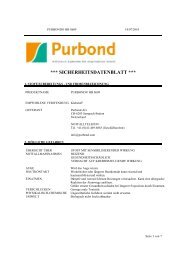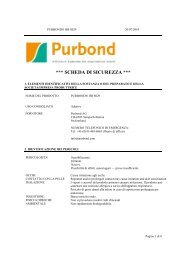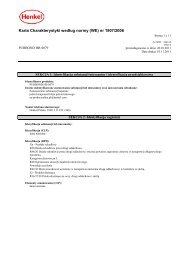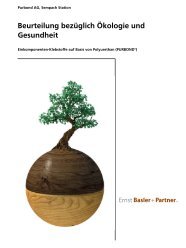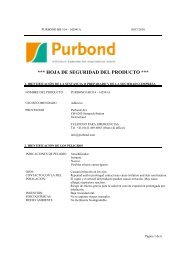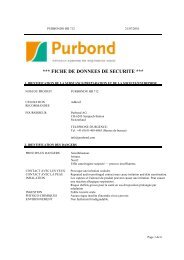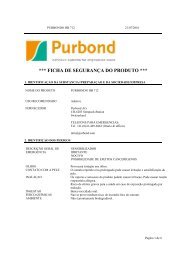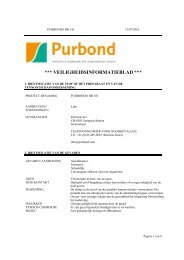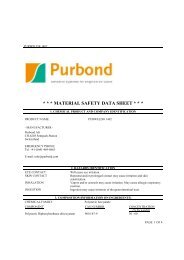MATERIAL SAFETY DATA SHEET
MATERIAL SAFETY DATA SHEET
MATERIAL SAFETY DATA SHEET
Create successful ePaper yourself
Turn your PDF publications into a flip-book with our unique Google optimized e-Paper software.
PURWELD® 1202 Print date: 11-February-2010<br />
*** <strong>MATERIAL</strong> <strong>SAFETY</strong> <strong>DATA</strong> <strong>SHEET</strong> ***<br />
1. CHEMICAL PRODUCT AND COMPANY IDENTIFICATION<br />
PRODUCT NAME: PURWELD® 1202<br />
liquid adhesive for bonding wood<br />
COMPANY ADDRESS Purbond AG<br />
CH-6203 Sempach-Station<br />
Switzerland<br />
2. HAZARDS IDENTIFICATION<br />
EMERGENCY OVERVIEW<br />
EMERGENCY PHONE:<br />
+41-(0)41-469-6863<br />
info@purbond.com<br />
WARNING.<br />
Respiratory irritant.<br />
EYE IRRITANT.<br />
RESPIRATORY SENSITIZER.<br />
SKIN SENSITIZER.<br />
Tan Liquid Negligible Odor<br />
EYE Will cause eye irritation.<br />
SKIN CONTACT Repeated and/or prolonged contact may cause irritation and skin sensitization.<br />
INHALATION Vapors and/or aerosols may cause irritation May cause allergic respiratory<br />
reaction.<br />
INGESTION Ingestion may cause irritation of the gastrointestinal tract.<br />
3. COMPOSITION/INFORMATION ON INGREDIENTS<br />
CHEMICAL FAMILY Polymeric Isocyanate<br />
COMPONENT CAS NUMBER CONCENTRATION<br />
PAGE 1 OF 6
PURWELD® 1202 Print date: 11-February-2010<br />
(% by weight)<br />
Polymeric Diphenylmethane diisocyanate 9016-87-9 30 - 60<br />
4. FIRST-AID MEASURES<br />
EYE Irrigate with eyewash solution or clean water until pain is relieved.<br />
SKIN CONTACT Wash skin with soap and water.<br />
INHALATION Remove to fresh air. If breathing is difficult, give oxygen. If breathing has<br />
stopped, give artificial respiration. Get medical attention.<br />
INGESTION Treat symptomatically and supportively. Get medical attention.<br />
5. FIREFIGHTING MEASURES<br />
AUTOIGNITION Not available<br />
FLASH POINT > 200 °C (Pensky-Martens Closed Tester)<br />
EXTINGUISHING MEDIA CO2; Dry Chemical; Foam<br />
SPECIAL FIREFIGHTING PROCEDURES Fire fighters should be equipped with self-contained<br />
breathing apparatus to protect against potentially toxic and<br />
irritating fumes.; Cool exposed equipment with water<br />
spray.<br />
FIRE & EXPLOSION HAZARDS Combustion will evolve toxic and irritant vapors.<br />
HAZARDOUS COMBUSTION PRODUCTS Decomposes upon heating to release toxic fumes of<br />
nitrogen oxides, carbon monoxide, carbon dioxide, and<br />
hydrogen cyanide.<br />
LOWER EXPLOSION LIMIT (%) Not applicable<br />
UPPER EXPLOSION LIMIT (%) Not applicable<br />
6. ACCIDENTAL RELEASE MEASURES<br />
SPILL AND LEAK PROCEDURES Allow to cool and solidify. Scrape up and collect in suitable containers for<br />
disposal. Ventilate area.<br />
For safety and environmental precautions, please review entire Material Safety Data Sheet for necessary<br />
information.<br />
7. HANDLING AND STORAGE<br />
STORAGE TEMPERATURE Room<br />
HANDLING/STORAGE Store at room temperature. Product contains<br />
hazardous volatile ingredients which could<br />
accumulate in the unvented headspace of drums or<br />
bulk storage vessels. Open drums in ventilated area.<br />
Avoid breathing vapors.<br />
SENSITIVITY TO STATIC ELECTRICITY No<br />
SPECIAL SENSITIVITY Avoid moisture contamimation.<br />
SENSITIVITY TO MECHANICAL IMPACT No<br />
8. EXPOSURE CONTROLS/PERSONAL PROTECTION<br />
COMPONENT EXPOSURE LIMITS<br />
PAGE 2 OF 6
PURWELD® 1202 Print date: 11-February-2010<br />
Polymeric Diphenylmethane<br />
diisocyanate<br />
ACGIH OSHA Mfg Working<br />
Standard<br />
0.005 ppm TWA. 0.02 ppm Ceiling; 0.2<br />
mg/m3 Ceiling<br />
EXPOSURE LIMIT NOTES Exposure limits for Polymeric Diphenylmethane diisocyanate are<br />
based on the limits set for the monomeric form (101-68-8).<br />
VENTILATION REQUIREMENTS Local exhaust to keep vapors below TLV.<br />
EYE PROTECTION REQUIREMENTS Safety glasses, goggles or face shield to protect against splashing.<br />
GLOVE REQUIREMENTS Employee must wear appropriate protective gloves to prevent contact with<br />
this substance.<br />
CLOTHING REQUIREMENTS Appropriate protective clothing and equipment is recommended to<br />
minimize skin contact with this substance.<br />
CHANGE/REMOVAL OF CLOTHING Remove contaminated clothing and launder before reuse.<br />
WASH REQUIREMENTS Wash before eating, drinking, or using toilet facilities.<br />
RESPIRATOR REQUIREMENTS NIOSH approved respirator if required. Self-contained breathing<br />
apparatus in emergency and non-routine situations.<br />
9. PHYSICAL AND CHEMICAL PROPERTIES<br />
PURE SUBSTANCE OR MIXTURE Mixture<br />
PHYSICAL FORM Liquid<br />
COLOR Tan<br />
ODOR Negligible<br />
ODOR THRESHOLD Not available<br />
PH AS IS Not applicable<br />
pH IN (1%) SOLUTION Not applicable<br />
OXIDIZING PROPERTIES Not applicable<br />
BOILING POINT Not applicable<br />
MELTING/FREEZING POINT Not available<br />
SOLUBILITY IN WATER Insoluble<br />
PARTITION COEFFICIENT (n-octanol/water) Not applicable<br />
BULK DENSITY 9.16 lb/gal<br />
EVAPORATION RATE Not applicable<br />
VAPOR PRESSURE (mmHg) Not available<br />
VAPOR DENSITY (air = 1) N/A<br />
VOLATILES None<br />
VOLATILE ORGANIC COMPOUNDS 10 g/liter<br />
AUTOIGNITION Not available<br />
FLASH POINT > 200 °C (Pensky-Martens Closed Tester)<br />
10. STABILITY AND REACTIVITY<br />
STABILITY Stable<br />
HAZARDOUS DECOMPOSITION PRODUCTS Decomposes upon heating to release toxic fumes of nitrogen<br />
oxides, carbon monoxide, carbon dioxide, and hydrogen<br />
cyanide.<br />
PAGE 3 OF 6
PURWELD® 1202 Print date: 11-February-2010<br />
11. TOXICOLOGICAL INFORMATION<br />
ROUTE OF ENTRY Inhalation; Ingestion; Skin Contact; Eye Contact<br />
CARCINOGEN IARC<br />
(group)<br />
COMPONENT<br />
There is no evidence that<br />
this product poses a<br />
carcinogenic risk under<br />
normal conditions of<br />
handling and use.<br />
ACUTE (SHORT TERM) EFFECTS OF EXPOSURE<br />
NTP OSHA Substance<br />
Specific Regulation<br />
CHRONIC (LONG TERM) EFFECTS OF EXPOSURE<br />
EFFECTS OF CHRONIC EXPOSURE The toxicological properties of this product have not been<br />
fully evaluated. Use of good industrial hygiene practices is<br />
required. Avoid direct contact with skin or eyes. Do not<br />
ingest or inhale.<br />
TARGET ORGANS Respiratory system; Skin; Eyes; Lungs; Gastrointestinal<br />
RESPIRATORY SENSITIZATION Sensitizer. May cause allergic reaction.<br />
SKIN SENSITIZATION Sensitizer. May cause allergic reaction.<br />
COMPONENT ORAL TOXICITY NOTES ON ORAL TOXICITY<br />
Polymeric<br />
Oral LD50: Rat > 15000 Irritant and may cause nausea and vomiting.<br />
Diphenylmethane<br />
diisocyanate<br />
mg/kg<br />
COMPONENT DERMAL TOXICITY NOTES ON DERMAL TOXICITY<br />
Polymeric<br />
Diphenylmethane<br />
diisocyanate<br />
Dermal LD50: Rabbit ><br />
5000 mg/kg<br />
Irritating to the skin. Repeated and/or prolonged<br />
contact may cause skin sensitization.<br />
COMPONENT INHALATION TOXICITY NOTES ON INHALATION TOXICITY<br />
Polymeric<br />
Diphenylmethane<br />
diisocyanate<br />
Inhalation LC50 (4hr): Rat<br />
490 mg/m3<br />
Respiratory irritant. Respiratory sensitizer.<br />
Extremely toxic. Exposure to high concentrations<br />
may produce lung damage. Symptoms may include<br />
irritation to the eyes, nose, throat and lungs, possibly<br />
combined with dryness of the throat, tightness of<br />
chest and difficulty in breathing. Symptoms may<br />
develop after several hours.<br />
PAGE 4 OF 6
PURWELD® 1202 Print date: 11-February-2010<br />
COMPONENT NOTES ON EYE IRRITATION<br />
Polymeric<br />
Will cause eye irritation.<br />
Diphenylmethane<br />
diisocyanate<br />
12. ECOLOGICAL INFORMATION<br />
POTENTIAL TO BIOACCUMULATE Unknown.<br />
AQUATIC TOXICITY None Established<br />
13. DISPOSAL CONSIDERATIONS<br />
WASTE DISPOSAL METHODS Disposal should be in accordance with local, state or national legislation.<br />
EMPTY CONTAINER WARNINGS Empty containers may contain product residue; follow MSDS and label<br />
warnings even after they have been emptied.<br />
14. TRANSPORTATION INFORMATION<br />
This section provided for general information only. The shipping description below may not represent<br />
requirements for all modes of transportation, packaging, shipping methods or locations outside of the United<br />
States.<br />
FOR MORE COMPLETE TRANSPORTATION REGULATORY INFORMATION PLEASE REFER TO THE<br />
SHIPPING DOCUMENTS ACCOMPANYING THE SHIPMENT OF THIS PRODUCT.<br />
DOT CLASSIFICATION Not regulated<br />
The information provided herein may not include the impact of additional regulatory requirements (eg, for<br />
materials meeting the definition of a hazardous waste under RCRA, hazardous substances under CERCLA, and/of<br />
marine pollutants under CWA or other similar federal, state or local laws) or any associated exceptions or<br />
exemptions under regulations applicable to the transport of this material.<br />
15. REGULATORY INFORMATION<br />
USA<br />
TSCA This product is manufactured in compliance with all provisions of the<br />
Toxic Substances Control Act, 15 U.S.C. 2601 et. seq.<br />
SARA - Section 313 (Superfund Amendments and Reauthorization Act of 1986 - 40CFR 372)<br />
CAS NUMBER CONCENTRATION<br />
(% by weight)<br />
Polymeric diphenylmethane diisocyanate 9016-87-9 47.481<br />
CALIFORNIA PROPOSITION 65<br />
WARNING: This product contains the following chemicals that are known to the State of California to cause<br />
cancer, birth defects or other reproductive harm.<br />
PAGE 5 OF 6
PURWELD® 1202 Print date: 11-February-2010<br />
Unless a concentration is specified in Section 2 of the MSDS, the below chemical/s are present in trace<br />
amounts.<br />
COMPONENT CAS NUMBER<br />
None reportable.<br />
16. OTHER INFORMATION<br />
HMIS® Hazard Ratings<br />
HMIS® ratings are based on a 0-4 rating scale, with 0 representing minimal hazards or risks, and 4 representing<br />
significant hazards or risks. Although HMIS® ratings are not required on MSDSs by OSHA's 29 CFR 1910.1200,<br />
we choose to provide them as a service to our customers using HMIS®. These ratings are to be used only with a<br />
fully implemented HMIS® program. To deal adequately with the safe handling of this material, all the<br />
information contained in this MSDS must be considered.<br />
NPCA recommends that employers must determine appropriate PPE for the actual conditions under which this<br />
product is used in their workplace. For information on PPE codes, consult the HMIS® Implementation Manual.<br />
When two ratings are provided for Health, the first represents the material 'as supplied', and the second represents<br />
the material 'in use'.<br />
* = chronic health hazard<br />
HMIS® is a registered trademark of the National Paint and Coatings Association (NPCA).<br />
Health Flammability Reactivity<br />
2 1 1<br />
MSDS DATE 11-February-2010<br />
FOR INFORMATION CONTACT: Regulatory Affairs<br />
ADDITIONAL INFORMATION: The information given and the recommendations made herein apply to our<br />
product(s) alone and are not combined with other product(s). Such are based on our research and on data from<br />
other reliable sources and are believed to be accurate. No guaranty of accuracy is made. It is the purchaser's<br />
responsibility before using any product to verify this data under their own operating conditions and to determine<br />
whether the product is suitable for their purposes.<br />
PAGE 6 OF 6



